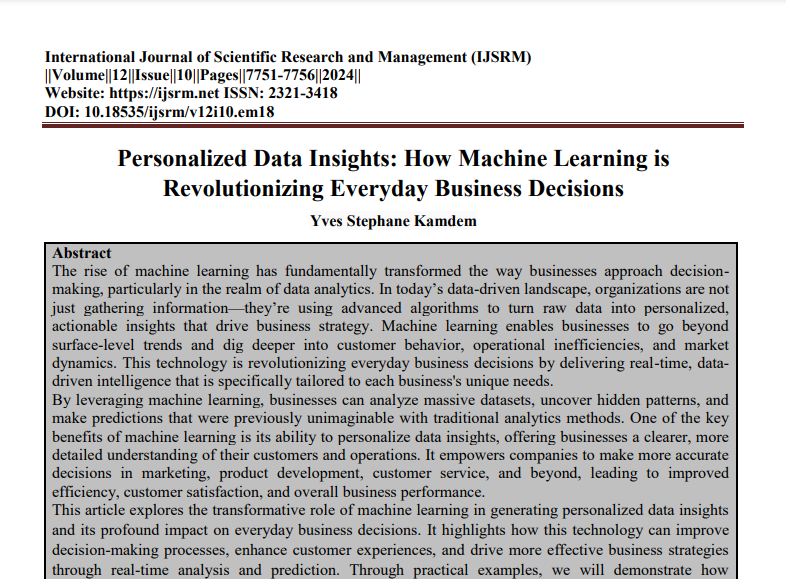Personalized Data Insights: How Machine Learning is Revolutionizing Everyday Business Decisions

Submission to VIJ 2024-10-24
Keywords
- Machine Learning, Data Analytics, Personalized Insights, Business Decision-Making, Real-Time Analysis, Predictive Analytics, Customer Behavior, Operational Efficiency, Business Strategy, Artificial Intelligence (AI), Data-Driven Decision-Making.
Copyright (c) 2024 Yves Stephane Kamdem

This work is licensed under a Creative Commons Attribution 4.0 International License.
Abstract
The rise of machine learning has fundamentally transformed the way businesses approach decision-making, particularly in the realm of data analytics. In today’s data-driven landscape, organizations are not just gathering information—they’re using advanced algorithms to turn raw data into personalized, actionable insights that drive business strategy. Machine learning enables businesses to go beyond surface-level trends and dig deeper into customer behavior, operational inefficiencies, and market dynamics. This technology is revolutionizing everyday business decisions by delivering real-time, data-driven intelligence that is specifically tailored to each business's unique needs.
By leveraging machine learning, businesses can analyze massive datasets, uncover hidden patterns, and make predictions that were previously unimaginable with traditional analytics methods. One of the key benefits of machine learning is its ability to personalize data insights, offering businesses a clearer, more detailed understanding of their customers and operations. It empowers companies to make more accurate decisions in marketing, product development, customer service, and beyond, leading to improved efficiency, customer satisfaction, and overall business performance.
This article explores the transformative role of machine learning in generating personalized data insights and its profound impact on everyday business decisions. It highlights how this technology can improve decision-making processes, enhance customer experiences, and drive more effective business strategies through real-time analysis and prediction. Through practical examples, we will demonstrate how businesses across various sectors are already using machine learning to revolutionize their operations and improve outcomes.
References
- Alpaydin, E. (2020). Introduction to Machine Learning (4th ed.). MIT Press.
- Bishop, C. M. (2006). Pattern Recognition and Machine Learning. Springer.
- Breiman, L. (2001). Random Forests. Machine Learning, 45(1), 5-32. DOI: 10.1023/A:1010933404324.
- Chui, M., Manyika, J., & Miri, A. (2016). Where machines could replace humans—and where they can’t (yet). McKinsey Quarterly. Retrieved from McKinsey.
- Domingos, P. (2012). A Few Useful Things to Know About Machine Learning. Communications of the ACM, 55(10), 78-87. DOI: 10.1145/2347736.2347755.
- Goodfellow, I., Bengio, Y., & Courville, A. (2016). Deep Learning. MIT Press.
- Kelleher, J. D., & Tierney, B. (2018). Data Science: The Basics. CRC Press.
- Khoshgoftaar, T. M., & Smith, A. M. (2009). Machine Learning: A Review. Journal of Computer Science and Technology, 24(6), 1-21. DOI: 10.1007/s11390-009-9165-0.
- LeCun, Y., Bengio, Y., & Haffner, P. (1998). Gradient-Based Learning Applied to Document Recognition. Proceedings of the IEEE, 86(11), 2278-2324. DOI: 10.1109/5.726791.
- Lohr, S. (2018). Data-ism: How Our Future Will Be Built on Big Data, Algorithms, and Machine Learning. Harper Business.
- Mohri, M., Rostamizadeh, A., & Talwalkar, A. (2012). Foundations of Machine Learning. MIT Press.
- Murphy, K. P. (2012). Machine Learning: A Probabilistic Perspective. MIT Press.
- Russell, S., & Norvig, P. (2016). Artificial Intelligence: A Modern Approach (3rd ed.). Pearson.
- Shalev-Shwartz, S., & Ben-David, S. (2014). Understanding Machine Learning: From Theory to Algorithms. Cambridge University Press.
- Varian, H. R. (2014). Big Data: New Tricks for Econometrics. Journal of Economic Perspectives, 28(2), 3-28. DOI: 10.1257/jep.28.2.3.
- Witten, I. H., Frank, E., & Hall, M. A. (2016). Data Mining: Practical Machine Learning Tools and Techniques (4th ed.). Morgan Kaufmann.
- Xu, B., & Zhu, J. (2018). A Survey on Machine Learning for Big Data. IEEE Transactions on Big Data, 4(4), 505-517. DOI: 10.1109/TBDATA.2017.2652305.
- Zhang, J., & Wang, Y. (2016). Data Mining and Machine Learning: Concepts and Techniques. Journal of Computer Science and Technology, 31(1), 1-19. DOI: 10.1007/s11390-016-1603-1.
- Zhao, X., & Wang, S. (2019). Machine Learning and Data Analytics in Business. Journal of Business Research, 104, 455-459. DOI: 10.1016/j.jbusres.2019.06.011.
- Zhou, Z.-H. (2012). Ensemble Methods: Foundations and Algorithms. CRC Press.